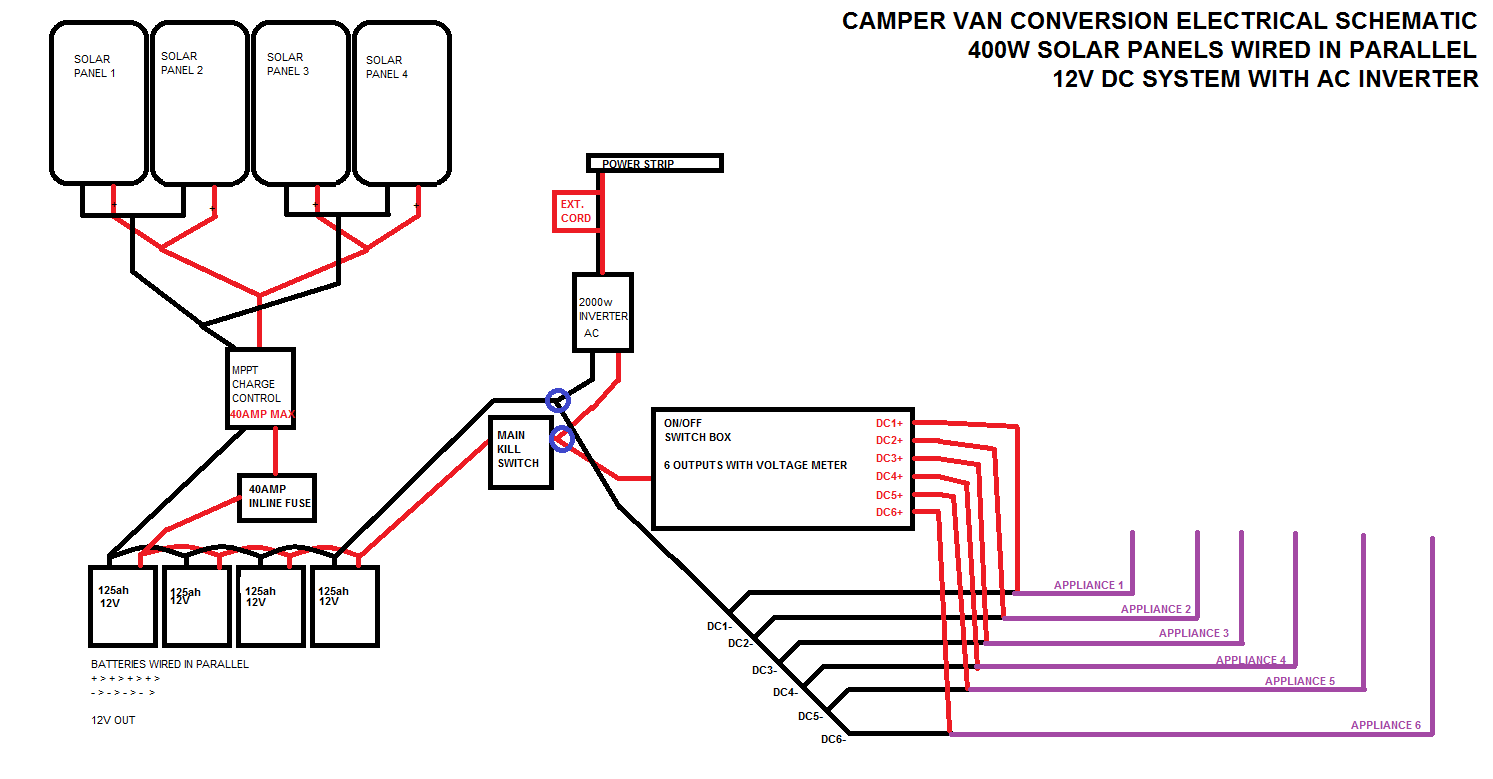You show a 45 amp controller, with a 40 amp fuse. Size your wire based on length and 45 amps to give you under 2% voltage drop. Then fuse close to the battery with 50 amp or more fuse, depending on what size wire you use. Do the same calculation for the inverter wires. Again fuse close to the battery. These are catastrophic failure fuses and are in addition to the fuses for the individual circuits.
You are using an out of date browser. It may not display this or other websites correctly.
You should upgrade or use an alternative browser.
You should upgrade or use an alternative browser.
Wiring Schematic
- Thread starter Feruko
- Start date

Help Support Van Living Forum:
This site may earn a commission from merchant affiliate
links, including eBay, Amazon, and others.
DannyB1954
Well-known member
A 2,000 watt inverter will use 167 amps. 2000 / 12 = 166.66666666. Watts is equal to the volts times the amps. I would have a 200 amp fuse coming out of the battery.
- Joined
- Dec 12, 2010
- Messages
- 7,706
- Reaction score
- 56
I have a 150 amps fuse between the battery and my 2000 watt inverter using 2/0 wire. My microwave only draws 1100 watts and that's the highest thing I'll ever use.
After 1000s of uses, its never blown the fuse. I check to see if anything gets hot--nothing ever has.
Bob
After 1000s of uses, its never blown the fuse. I check to see if anything gets hot--nothing ever has.
Bob
DannyB1954
Well-known member
ccbreder said:My inverter recommended a 250 amp fuse with 2/0 cable. A larger fuse will offer lower resistance, while still protecting the wire.
There really should be no resistance going through any fuse. The reason a fuse is in there is if for any reason the cable shorts out the fuse will blow. A battery(s) have enough power in them to become an arc welder. As Bob did, I sized my fuse to be able to handle any load I would put on the system. In my case it is a 200 amp feeding a 3,500 watt inverter. In theory the inverter could use up to 292 amps. I could probably put a 100 amp fuse in there and it would be just fine for my loads. Just make sure that the wire you use will handle whatever the fuse is rated for.

$12.98
$29.99
Augason Farms Black Bean Burger Mix Can, Certified Gluten Free, Emergency Food Supply, Everyday Meals, 38 Servings
Amazon.com

$46.00 ($1.68 / Ounce)
Greenbelly Backpacking Meals | All Natural Hiking Meal Bars | 650 Calories & High Protein | Variety, 5 Count
Greenbelly

$74.98
$99.99
Augason Farms Lunch and Dinner Variety Pail Emergency Food Supply 4-Gallon Pail
Amazon.com

$17.00
$19.95
The Van Life Cookbook: Delicious Recipes, Simple Techniques and Easy Meal Prep for the Road Trip Lifestyle
Amazon.com

$30.59
$40.00
The Van Conversion Bible: The Ultimate Guide to Converting a Campervan
Amazon.com

$33.63
$39.90
Van Build: A complete DIY guide to designing, converting and self-building your campervan or motorhome
Amazon.com
Spaceman Spiff
Well-known member
- Joined
- Apr 5, 2014
- Messages
- 2,650
- Reaction score
- 655
DannyB1954 said:There really should be no resistance going through any fuse ...
Measured voltage drop (due to resistance) across different sized fuses:
http://www.pbase.com/mainecruising/fuse_voltage_drop
-- Spiff
DannyB1954
Well-known member
Once you get close to the maximum capacity of the fuse it will get hot and there will be resistance. It is not a good practice to push the current at the maximum capacity of the fuse and wire. The fuse works by getting hot and melting. If you are running a 20 amp load through a 40 or 60 amp fuse, the resistance should be the same. Negligible. The thing that will give a lower resistance is to use a larger wire.
Feruko said:Hello everyone,

Hi and welcome.
Your diagram does not have a required fuse, 20 amp for the 4 x 100 watt (20v * 5a) panels, between the solar panels and the charge controller. This protects the charge controller on the solar side.
Based on my experience, I do not think that 400 watts would keep that size of a battery bank happy.
I have 400 watts with two group 29 12v and when I only have two panels operating, 200 watts. (Problems with newer, flaky Renogy 1.5 ft cables that use thinner cabling than the originals. I am replacing those cables before departing on a summer tour.) There are issues with keeping the batteries charged when only used for a Whynter 65 qt reefer at 39F , draw is 5 amps when cooling. I am in southern Nevada with intense sunlight. A set of two panels provided 8+ amps with yesterday's sky. It has been more humid for a couple of days.
I found humidity has a large affect on solar. I know that from under fusing the CC with a 15 amp fuse. All summer long in the Northeast (high humidity) no problem. When the air dried out in late September the 15 amp fuse blew as the panels produced 20 amps.
-Wayne
DannyB1954
Well-known member
wayne49 said:I found humidity has a large affect on solar. I know that from under fusing the CC with a 15 amp fuse. All summer long in the Northeast (high humidity) no problem. When the air dried out in late September the 15 amp fuse blew as the panels produced 20 amps.
-Wayne
The fuse itself may also have gotten hot by the sun shining on it. I am also Southern Nv. You leave a wrench laying out on a hot day, you don't want to pick it up bare handed.
Spaceman Spiff said:Measured voltage drop (due to resistance) across different sized fuses:
http://www.pbase.com/mainecruising/fuse_voltage_drop
-- Spiff
Well worth reading this article before choosing fuse sizes.
Similar threads
- Replies
- 5
- Views
- 801


































































